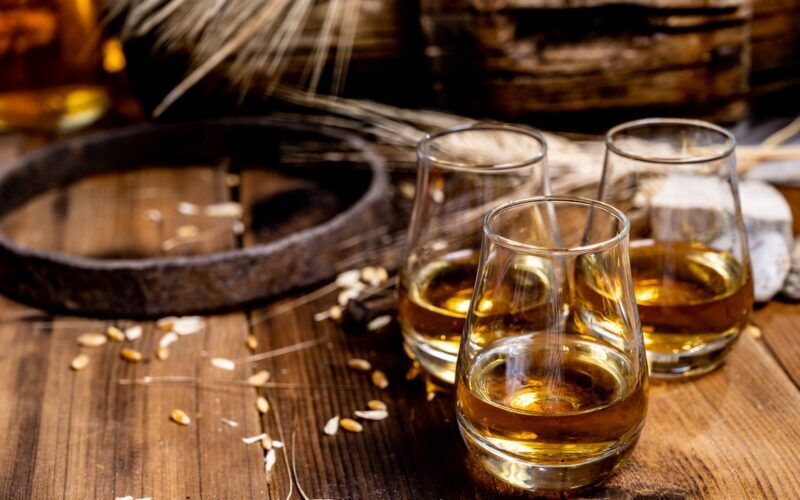There are a lot of things in this world that demand respect—rank, tradition, and whiskey. Especially whiskey.
Whether you’re a new recruit to the whiskey world or looking to brush up on the fundamentals, this guide will walk you through what makes whiskey… well, whiskey. From grain to glass, we’ll break down the key steps in production, explore how bourbon and rye fit into the mix, and settle the age-old debate: whiskey vs. whisky—what’s the damn difference?
So grab a glass (neat or on the rocks, no judgment here), and let’s get started.
Whiskey 101: What Exactly Is Whiskey?
At its core, whiskey is a distilled alcoholic beverage made from fermented grain mash, aged in wooden barrels—typically oak. But don’t let that simple definition fool you. This spirit is as diverse as the people who drink it, with styles and flavors shaped by ingredients, geography, and centuries of tradition.
No matter where it’s made—Kentucky or Canada, Ireland or Indiana—whiskey must be distilled from grain, undergo fermentation, and spend time aging in barrels. That’s the baseline. But from there, the devil is in the details.
The Core Ingredients: Grains Make the Difference
Every bottle of whiskey starts with grain. The type of grain used in the mash bill (recipe) plays a huge role in defining the final flavor:
- Corn – Sweet and creamy. The backbone of bourbon.
- Rye – Spicy and bold. Adds pepper and dry character.
- Wheat – Soft and mellow. Think smoother, breadier notes.
- Barley – Earthy and nutty. Essential for Scotch and Irish whiskey.
Most American whiskeys use a combination of grains, often with a majority grain that defines the category—like 51% corn for bourbon or 51% rye for, well, rye whiskey.
It’s kind of like building your fire team: each grain brings something different to the mission, but one always takes point.
Step One: Mashing & Fermentation
The grains are ground into a coarse flour and mixed with hot water to extract sugars—this is called **mashing**. The result is a sugary liquid called *wort*.
Next comes **fermentation**, where yeast is added to the wort to convert those sugars into alcohol. Over a few days, the yeast throws a party—eating sugar, producing alcohol, and creating flavors. When fermentation is complete, you’ve got a beer-like liquid (called *wash*), usually around 7–10% ABV.
You wouldn’t want to drink it at this stage—it’s more mess hall than officer’s club—but it’s the foundation of all great whiskey.
Step Two: Distillation – Separating the Strong From the Weak
Now it’s time to crank up the heat. **Distillation** is the process of boiling the wash in a still (usually copper) to separate alcohol from water and other components. The goal is to concentrate the alcohol and refine the flavors.
In the U.S., whiskey is typically distilled twice, and the law says it can’t come off the still higher than **160 proof (80% ABV)** if you want to call it whiskey. Go above that, and you’re veering into vodka territory.
This is also where cuts are made—distillers keep the “hearts” (the good stuff) and toss the “heads” and “tails” (undesirable flavors). It’s an art and a science, kind of like dialing in your gear before a mission.
Step Three: Aging – Where the Magic Happens
Once distilled, the whiskey is placed in barrels to mature. For **bourbon and most American whiskey**, those barrels must be **new, charred American oak**. This aging process adds color, smooths out rough edges, and infuses the spirit with vanilla, caramel, spice, and oak notes.
By law, bourbon has no minimum aging requirement unless it’s labeled “straight” (which requires at least 2 years), but most quality whiskeys spend **4 to 10 years** in the barrel.
Why does it matter? Because time and wood are what separate the greenhorns from the veterans. An unaged spirit is like a fresh recruit—full of potential, but not ready for the big leagues. Aging turns raw spirit into something complex, balanced, and worthy of a salute.
Whiskey vs. Whisky: A Matter of Spelling… and Origin
Let’s clear this one up for the barracks:
“Whiskey” is used in the United States and Ireland
“Whisky” is used in Scotland, Canada, and Japan
The spelling difference is more about geography than substance, but it does hint at stylistic differences.
Scotch whisky (note the “no e”) is typically made from malted barley and distilled in pot stills. It’s often peated (smoky) and aged in used barrels like sherry or ex-bourbon casks.
Canadian whisky is usually lighter and made with a blend of grains. Fun fact: much of it technically qualifies as rye whisky, even if there’s barely any rye in the mix.
Irish whiskey is generally triple-distilled for smoothness and made from a mix of malted and unmalted barley.
So if you’re spelling it with an “e,” you’re probably talking about American or Irish whiskey. And if someone tries to correct your spelling, just tell them you follow your own standard operating procedures.
Bourbon vs. Rye: American Whiskey’s Dynamic Duo
Bourbon
Let’s start with the big dog. Bourbon is America’s native spirit (literally—Congress said so in 1964). To be legally called bourbon, it must:
- Be made in the U.S.
- Contain at least 51% corn
- Be aged in new, charred oak barrels
- Be distilled at no more than 160 proof
- Enter the barrel at no more than 125 proof
- Be bottled at no less than 80 proof
Bourbon is rich, sweet, and smooth, with flavors like vanilla, caramel, and toasted oak. Think of it as the dependable workhorse—always ready, always reliable.
Rye Whiskey
If bourbon is your reliable squad leader, rye is the firebrand. It’s made from at least 51% rye grain, giving it a spicier, drier character. You’ll get notes of cinnamon, black pepper, baking spice, and often a little citrus zest.
Rye has been enjoying a comeback in recent years, especially among those who want a bit more edge in their glass. It’s the whiskey equivalent of strapping on your combat boots and charging into the unknown—bold, assertive, and unforgettable.
Other Types Worth Knowing
- Tennessee Whiskey – Technically bourbon, but goes through the Lincoln County Process (charcoal filtering) for added smoothness. Jack Daniel’s is the poster child.
- Single Malt Whiskey – Usually made in Scotland or Japan from 100% malted barley at a single distillery.
- Blended Whiskey – A mix of different distillates, often including grain whiskey and malt whiskey. Common in Scotch and Canadian whisky.
Final Thoughts: Why It Matters
Whiskey isn’t just a drink—it’s a story in a bottle. Every dram is shaped by its ingredients, its distiller, its region, and its time in the barrel. Whether you’re sipping a small-town rye from a craft distiller or pouring a pour from a heritage Kentucky house, you’re engaging with history, craft, and culture.
As a veteran, I respect anything that’s stood the test of time and gone through fire to come out better on the other side. That’s whiskey. Grain, heat, pressure, patience—and pride.
So next time someone hands you a pour, you’ll know what’s in your glass. Not just in terms of ingredients or proof, but legacy. And that’s worth raising a toast to.

